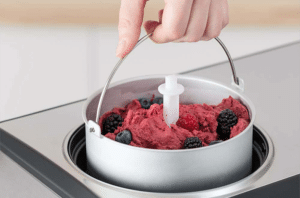
Quality has always been at the heart of consumers' concerns. The latter translates into several determining criteria which are linked, so that the final product meets the customer's expectations. The abundance of ice is obviously part of it, but here are the following:
- The selection of incorporated raw materials (dairy products, ESDL, fats, sugars, combined stabilizers and aromatic ingredients). All these elements will give a viscosity to the mix which will then give it an expansion capacity.
- The machine in which the ice cream is produced and the processes used (a small variation in the methodology will modify the maximum emulsifying power)
- The know-how of the ice cream maker
When we talk about ice cream, most of us think of the famous cones that we find in every supermarket. But the largest representative volumes are ice called in “bins”. If the composition of the “ice cream mix” is specific to each artisan, the manufacturing processes must be applied in compliance with the code of good practice.
Ice cream in stages:
Two steps are essential in the ice cream making process :
- Pasteurization
It guarantees the sanitary quality of the product
- Ripening
The development of aromas and the action of stabilizers which capture the water contained in the raw materials of the mix.
- Switching to an ice cream maker
This is the process by which microbubbles of air are incorporated in order to bring softness and smoothness to the ice cream so that it does not freeze in a frozen square or it would be impossible to form any ball!
But then what is the difference between an ice cream maker with a horizontal tub and an ice machine with a vertical tub, you will say?
The principle of the horizontal tank is a powerful and rapid expansion. However, the craftsman has less control over this process, so it is the machine and the composition of the mix that will determine the rate of expansion of the ice cream.
When using a vertical tank, the expansion is less prolific at the base, but the artisan has complete control over the texture of his ice cream.
Originally, horizontal ice turbines had an expansion capacity of around 55% to 100% against 40 to 60% for vertical turbines.
However, these data remain theoretical, evolutions in terms of engines and set of spatulations have reduced the variations in expansion rate between horizontal and vertical ice turbines.
The result is final. The ice cream is denser in the mouth but with a simple adjustment on the speed variator, the motor will go up in the towers to bring in air and make the ice cream creamier. It is the craftsman who manages, and if the craftsman trusts our machines, we trust the craftsman!
At Hubert Cloix, we have chosen to mainly offer ice cream makers and ice cream turbines equipped with vertical tubs (although the noise from the hallways tells me that we are working on a brand new professional ice cream maker with horizontal tub). Gravity does its job, the expansion is controlled by the glacier, in short, you will understand, we are convinced that it is the best system for quality ice cream!


 by
by